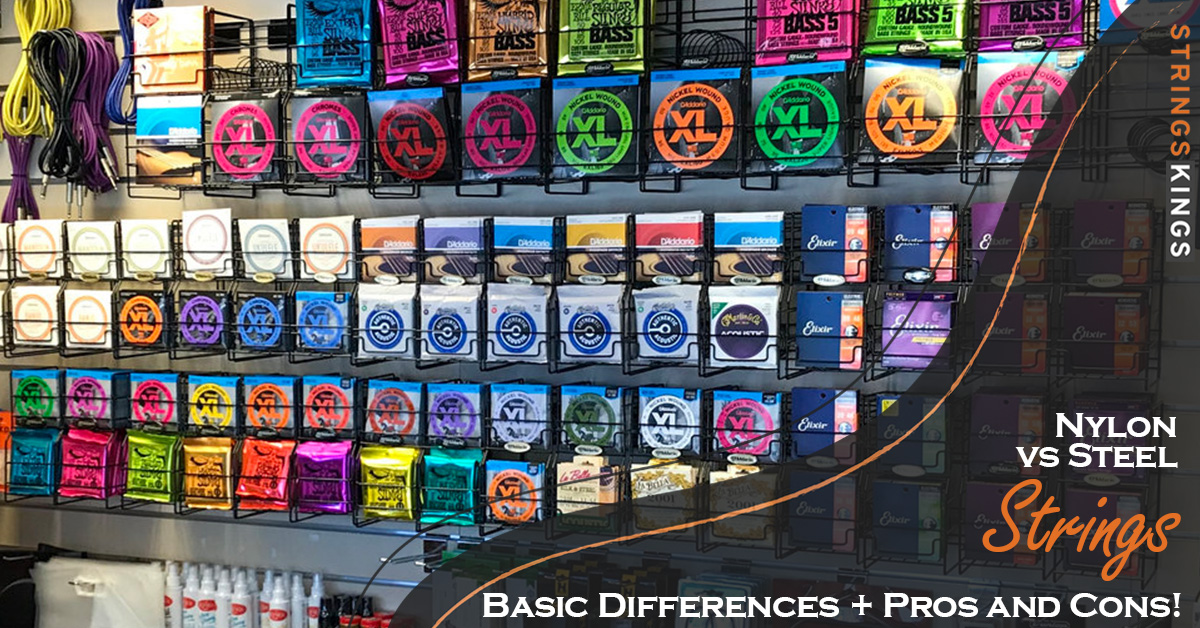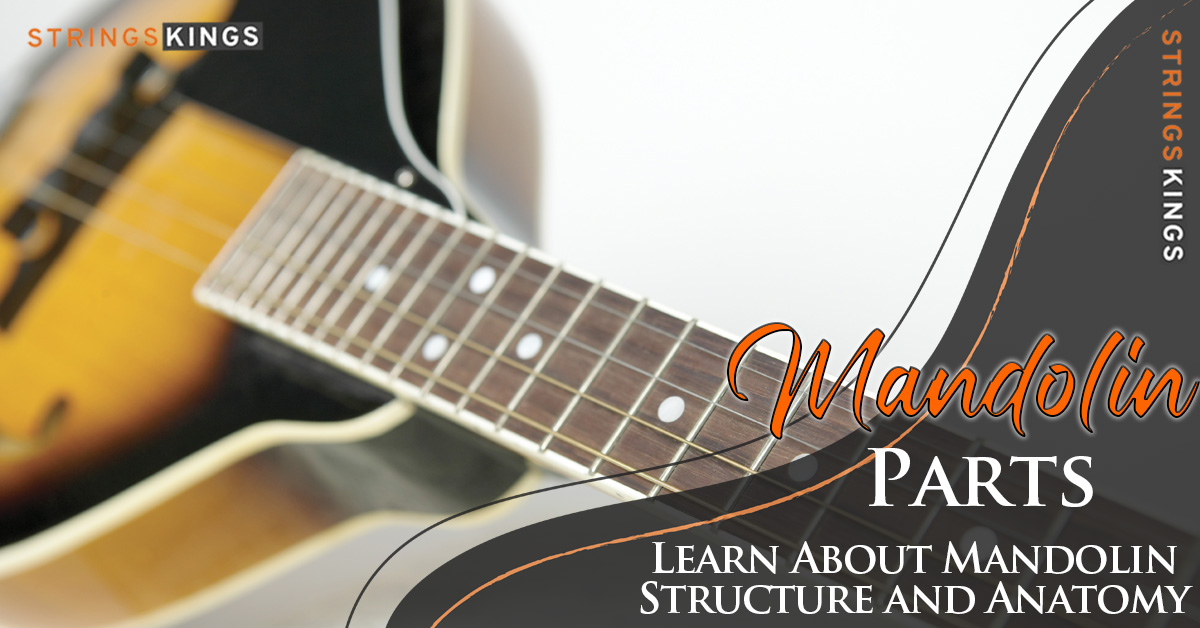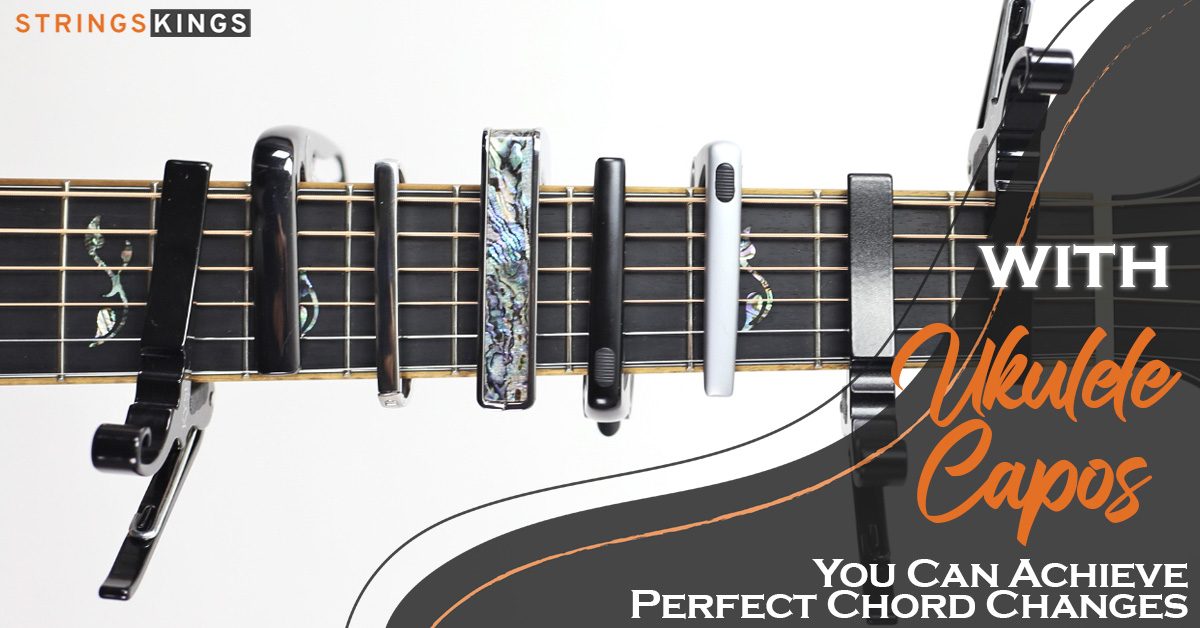Table of Contents
The Importance of Guitar Pickups and How They Affect Your Sound
There are no two electric guitars that sound alike. There are many factors involved, but one of the most important is the pickups. Even pickups from the same brand, variety, and technology can differ depending on some parameters.
What factors determine the tone and guitar pickups sound? The three main factors that determine the tone of a pickup are the design, the position, and the technology. A variety of other external factors also play a role in the performance of the pickups and the guitar’s output, including the tone and volume controls, strings, cables, and the signal chain.
We will discuss the internal and external factors that affect the pickup sound in this article.
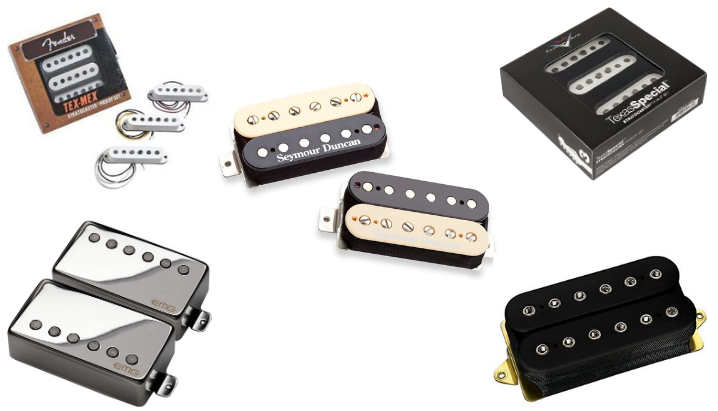
Guitar Pickups Sound/Tone: Factors That Affect Them
As we saw earlier, a pickup’s sonic characteristics are shaped by three main factors. The main factors are subordinate to several “sub-factors,” which require further exploration.
- Design
- Position
- Transducer technology
1. Pickup Design
This is probably the most important factor. A pickup’s design includes its external appearance as well as how its components work together.
Among the specifications of the design are:
Number Of Coils:
Circuits are operated by coils under a bobbin embedded with magnets. Coils are visually represented in each row. There are usually one or two coils in a pickup (and in some cases, even three).
Some popular electric guitar models still feature one-coil pickups, which were originally used in primitive electric guitars. Single-coil pickups were designed to eliminate the noise problem, but dual-coil pickups weren’t able to replace them completely.
Two coils are attached to the magnets in polar opposite directions in order to cancel out 60 Hz (or 50 Hz) hum and electromagnetic interference (EMI) more generally. As a result, the output is much cleaner. Due to noise filtering, the sound loses some dynamics and high-end frequencies.
Since single-coil pickups are not as EMI-rejecting as humbuckers, they are a viable alternative for many guitar players.
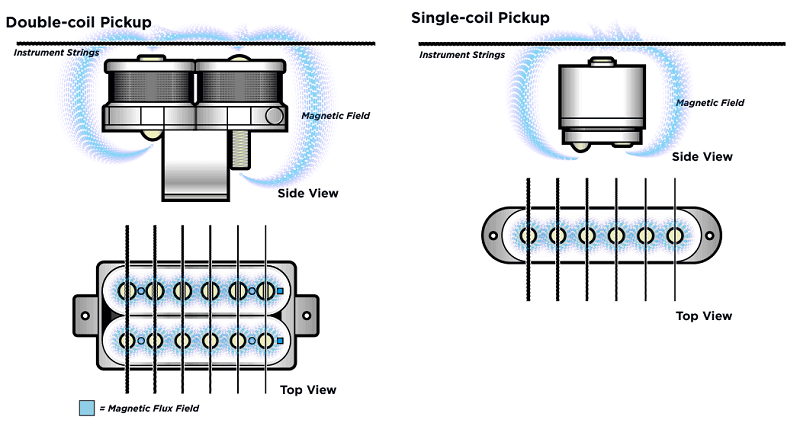
Windings:
Pickups are typically constructed with one or two coils, as stated above. There are several turns of enameled copper wire wound around the magnets to make these coils.
Depending on how many turns the coil is wound around the magnet, the output level will be determined. Although manufacturers do not have a rule of thumb for this aspect, it is generally expected that single-coil pickups will be wound 7,000-8,000 times, while dual-coils will be wound 4,500-5,000 times. For boosting lower frequencies, bass pickups are typically wound with more turns (in other words, “hotter”).
The number of turns per coil will generally determine the sound’s middle range. With more turns per coil, the midrange gets higher, making the sound “beefier” and darker. A pickup that is overwound will sound too big and less nuanced, while one that is underwound will sound tinny and “glassy”.
Similarly, the winding tension and mechanism, the wire diameter and length, and the distance between the coil and the magnet will also affect resistance and sound.
Cover:
Covers are implemented on some pickups (especially dual coils). Noise cancellation is supposed to be improved by grounding the electronics and shielding the pickup from radio frequency interference.
There is considerable debate regarding how much a cover may influence the guitar pickups sound/tone. By removing the cover, some argue that the tone becomes sharper. Especially if the cover is metal. Despite this, most people think the cover produces a flatter response.
Magnets:
Magnets can influence the overall tone of a guitar, though sometimes the differences aren’t noticeable.
Alnico magnets are smoother and warmer, while ceramic magnets tend to produce tangier notes.
Also, the magnet’s shape is different. In P90 pickups, there’s a magnet bar below the poles, so the sound is more evened out and thicker.
The diameter plays a big role in the pickup’s sustain. J-Bass pickups have smaller pole pieces paired parallel to each string, emphasizing initial attack over prolonged vibration.
Active Circuitry (Preamplifier):
In active pickups, there’s a preamplifier that amplifies the signal. Additionally, they reduce noise by filtering electromagnetic interference and affect the frequency response (EQ) and impedance of the audio.
In passive pickups, the guitar outputs the signal almost directly (it usually passes through a tone-shaping circuit, which we’ll explain later). Active pickups have tone shaping built into their printed circuit board (PCB) preamplifier circuits.
EQing can be done on PCBs in a variety of ways and is up to the pickup designers and manufacturers.
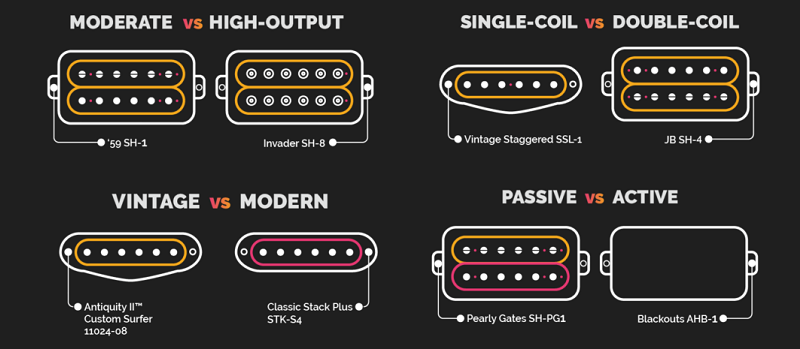
2. Pickup Position
It’s also important to consider where the pickup is relative to the strings and the guitar’s body.
It can be the spot or the location of the pickup, or it can be the height.
Location:
Pickups cover a radius, capturing vibrations from their surroundings and highlighting their frequency.
A neck pickup will interact with strings at their amplitude peak, whereas a bridge pickup will highlight the strings’ motion at their anchor point, which is much more restricted and, therefore, higher in frequency.
Height:
Height is the distance between the strings and the pickup (as a whole or individual pole piece).
The higher the pickup, the more magnetic attraction is produced, so the volume goes up. When the pickup is raised too high, magnetic interference can produce tuning issues or unwanted overtones, which affect the strings’ sustain. If the magnets are too far away from the strings, the pickup will lose signal and sound dampened.
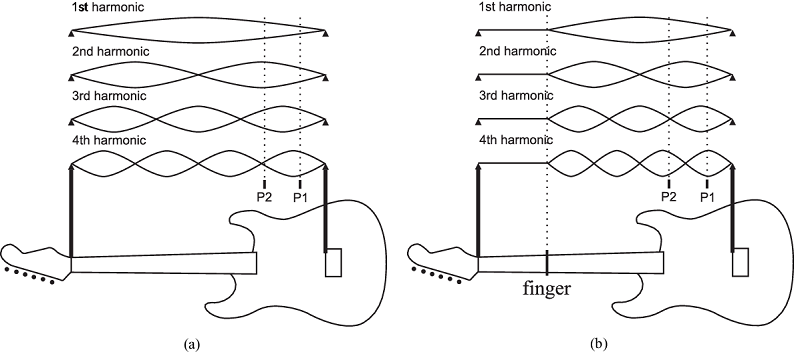
3. Transducer Technology
You can also change the sound of a pickup by changing the way it works and how it interacts with the strings.
Nowadays, most pickups use electromagnetic transducers. In addition, there are less common pickups that turn the vibration of the strings into sound.
Magnetic Pickups:
Electric guitars and basses have magnetic pickups. In combination with the guitar strings, they generate a magnetic field.
Current travels through a circuit because of the disturbance of this magnetic field. So mostly the metal strings interact with the pickup, whereas vibrations from the wooden body and non-metal parts are less emphasized.
Magnetic pickups are usually passive. The active pickup is a type of magnetic pickup that filters noise and boosts the signals (powered by a 9V battery) instead of just being a transducer. Compared to passive pickups, active pickups also have their disadvantages, like a lower dynamic range.
Piezoelectric Pickups:
Meanwhile, piezoelectric pickups work by converting pressure changes caused by vibrations into electric signals through crystals, not magnetic fields.
Usually placed under the saddle, these pickups pick up both strings and wood vibrations. That’s why piezoelectric pickups are touted as more acoustic.
Optical Pickups:
You don’t see these very often. They work by detecting string movement with infrared sensors.
The cleanest guitar sounds come from optical pickups because they’re virtually interference-free. Their sound layering isn’t as broad as magnetic or piezoelectric pickups, plus they’re more heat-sensitive.
How Do Tone Controls Work?
Pickups on electric guitars have tone control knobs that shape their sound. However, they don’t affect the pickups directly, but they have a big impact on the overall sound. They alter the audio signal after the pickups transduce it.
Pickups don’t come with tone controls, but they’re incredibly important for tone shaping.
Tone control (or multiple tone controls) will affect the output signals of one or more pickups depending on the guitar model. Tone controls adjust potentiometers in what are basically low-pass filters (LPFs).
As you roll the tone knob toward maximum, more high-frequency audio signal content will pass through, resulting in a brighter tone. On the other hand, turning the tone knob to a minimum will result in a darker tone by filtering the signal at lower cutoff frequencies.
It’s common for LPF to have a natural resonant boost near the cutoff frequency. By rolling the tone knob down, you can boost important frequencies near the cutoff. At other positions, it might produce an annoying resonant peak.
What’s the Deal With Volume Controls?
Controlling the volume on an electric guitar affects the output level of the audio signal.
Due to their real-world components, these controls will have some effect on the overall tone of the guitar, even though they should only affect signal level.
In addition, adjusting levels at any point in the signal path affects tone. Changes in guitar output level mean pedals, preamps, and power amps further down the line will have different signal levels.
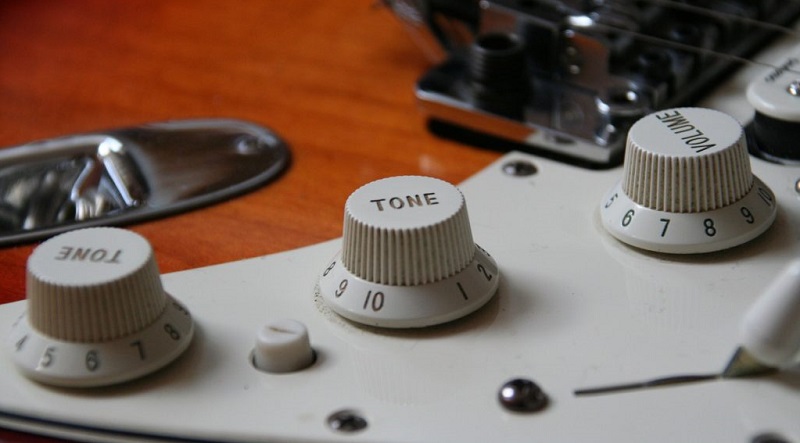
Other Things That Affect Electric Guitar Tone
There are other factors that can affect the tone of an electric guitar besides the built-in electronics. Additional resources will be included where appropriate.
Guitar Strings
Tone can be affected by strings. Tone can be affected by magnetic properties, gauge (thickness), age/wear, and tuning/tension.
Guitar Pedals
The tone is affected by effects and pedals. The tone depends on the circuit’s quality and effect. A true bypass pedal and a buffered bypass pedal can also affect the tone differently.
Guitar Patch Cables
The tone is affected by patch cables. A long unbalanced tip-sleeve guitar patch cable will have more distributed capacitance, which acts as a low-pass filter.
Guitar Amplifiers
The tone will be affected by the amplifier. This mostly applies to the preamp, though the power amp will also affect the overall sound. When the gain is applied, the tone can be shaped. There’s a difference between “dirty” and “distortion” channels. Tube amplifier circuits tend to behave differently when it comes to gain and tone shaping than solid-state amplifier circuits.
Guitar Cabinets
Tone can be affected by the speaker and speaker cabinet of a guitar amp. Larger speakers produce more low-end but suffer in the high-end. Speaker input and amplifier output should be matched/bridged in terms of power output/handling and impedance.
Guitar Tonewoods
The tone is affected by wood (or composite material), but not as much as acoustic guitars. Guitar tonewoods affect the sound of these instruments based on their density, hardness, and natural characteristics.
Final Words
By reading this article, hopefully, you’ve learned a thing or two about the parts of your tone that vary depending on what guitar pickups you’re using.
There are a lot of pickups out there, and a lot of them do some things better than others, so it’s up to you to research and figure out what sounds best for you.
However, if you change the pickups in a cheap guitar, just about anything will sound better than those. I suppose that’s just a testament to how important guitar pickups are.
You might still find the tone you want with new pickups, even if your guitar is decent. Try listening to some pickups and see which ones inspire you.


